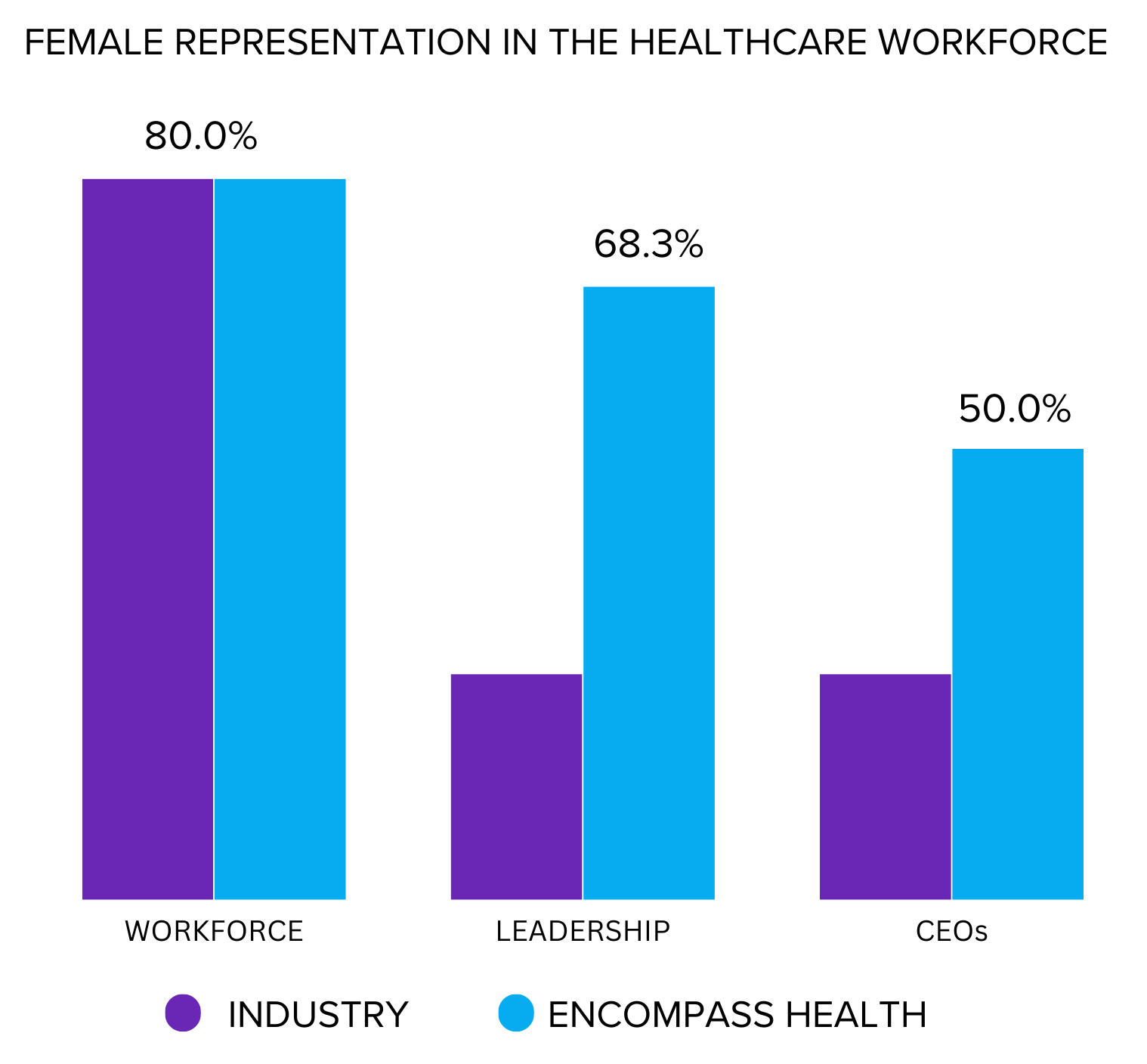Key Takeaways
- Despite making up three-quarters of the healthcare workforce in the United States, women hold less than a quarter of senior hospital leadership positions nationwide.
- Encompass Health beats the benchmarks, with women holding more than 60% of our hospital leadership positions and 50% of our hospital CEO positions.
- Employers can take practical steps to promote gender equity in their workforce development.
During the height of the COVID-19 pandemic, women across the United States left their jobs in record numbers. According to the U.S. Chamber of Commerce, an estimated one million women are missing from the post-pandemic labor market. Meanwhile, the women remaining in the workforce face a notable lack of career advancement opportunities.
Sometimes, employers simply fail to deliver employee recognition and career ladder programs that incorporate female professionals at the same rate as their male peers. In some cases, a women’s career must compete with the disproportionate burden of unpaid household labor that women also shoulder. It’s not surprising that more than half of women surveyed in recent LinkedIn research say a lack of flexible work options has pushed them to leave a job.
Female leaders at Encompass Health touched on this topic in a 2022 episode of EHC Today. Although no single company has the power to change the socioeconomic and interpersonal issues contributing to gender inequality, employers can step up to promote equity in their leadership structures and workforce development.
The Stats About Women in Healthcare
Of all the healthcare workers nationwide, women make up 70-80% of the healthcare workforce. There are many reasons why people believe women pursue healthcare careers in such high numbers. One common citation is that women tend to seek healthcare services more often than their male counterparts and make most of the healthcare decisions for their household.
Despite making up half of the U.S. population and three-quarters of the healthcare workforce, women only hold 20-25% of senior hospital leadership positions. According to a 2023 article by Harvard Public Health, women are underrepresented in leadership positions at Fortune 500 healthcare companies, global health organizations, top medical schools and departments of health in every country. Women of color hold even fewer healthcare leadership positions than their white peers. But it doesn’t have to be this way.
“At Encompass Health, we’ve seen a positive shift in our leadership demographics during the last decade,” said Laterrica Shelton, Encompass Health’s national director of diversity, equity and inclusion. “Roughly 68% of our senior hospital leadership teams are women. Of those, 21% are women of color. We not only want to have female leaders, but also great diversity among those women, so we can better serve our diverse patient population.”
Steps Toward Gender Equity in the Healthcare Workforce
While some sectors have seen a rise in women in leadership positions, the healthcare industry continues to move slowly. Luckily, there are some practical steps that healthcare leaders and HR teams can take to promote gender equity:
- Create a workplace that is psychologically safe: Ensure a zero-tolerance policy for sexual harassment and a no-retaliation policy for reporting ethics and compliance concerns. This benefits all employees, but especially those who are statistically more vulnerable to discrimination and even assault. “Women who feel supported, valued and safe in the workplace are more likely to stay with an employer long-term and pursue leadership opportunities,” Shelton said.
- Educate against bias in performance reviews: To mitigate potential bias in the talent rating process, Shelton partnered with Encompass Health’s organizational development team to train people managers on best practices for performance reviews. “We’ve aligned DEI efforts with other HR processes to make evaluations fair, reduce gender bias and increase diversity in our candidate pools, both internal and external,” Shelton said. “This has contributed to a 5.6% increase in diversity in hospital leadership positions over the past year.”
- Include female leaders in succession planning: In healthcare, the sharpest decrease in the promotion of women occurs at the jump from manager to senior manager. Echoing the advice above, employers can combat this by proactively including female candidates in succession planning practices. Publicize the skills and qualifications required for advancement to ensure all employees, regardless of gender or background, have an equal understanding of the next steps in their career ladder. Encourage female representation on key committees in your organization to ensure women have sufficient visibility and are contributing to decision-making at all levels.
- Celebrate positive examples: Honor female leaders by promoting their expertise as thought leaders, nominating them for professional awards and positioning them as valuable mentors. At Encompass Health, nurses can be nominated for both internal and external nursing excellence awards. The Company has also nominated and recognized female leaders named to Modern Healthcare’s Most Influential Clinical Leaders list, Top 40 Under 40 lists and many other professional programs. When women see other female leaders claim these accolades, it becomes easier to envision themselves in similar positions.
- Encourage female researchers: Without women leading research, there are fewer women authoring manuscripts, fewer women cited as subject matter experts and, subsequently, fewer women in leadership positions. For nearly a decade, Encompass Health has made efforts to promote therapy research. Since the inception of its research grant program in 2016, more than a dozen female clinicians have received funding from the Company for research that demonstrates the efficacy of therapy practices in the inpatient rehabilitation care setting.
Why It Matters
Women represent a large, qualified talent pool. Healthcare demands are predicted to skyrocket alongside the aging population during the next decade. As such, women in the workforce should not be overlooked. If this country’s healthcare industry continues leaving women on the fringes of leadership, we risk not only losing valuable female leaders now—but potentially the next generation of female leaders, too.
Encompass Health will continue its efforts to ensure all employees, including women, have equitable opportunities to advance their careers.
The content of this site is for informational purposes only and should not be taken as professional medical advice. Always seek the advice of your physician or other qualified healthcare provider with any questions you may have regarding any medical conditions or treatments.




